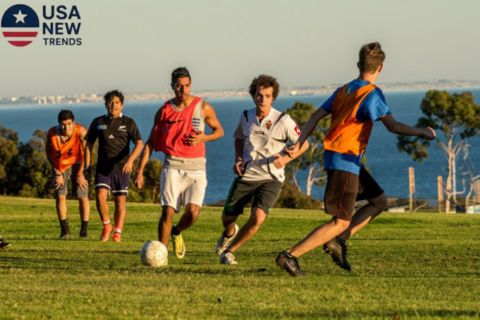Intramural sports in student life are more than just games—they are powerful tools for growth, connection, and well-being. As college sports programs evolve, students are turning to intramural activities for fun, fitness, and friendship. These activities promote physical fitness, encourage teamwork, and help students build essential life skills. Whether it’s joining an intramural basketball league or trying out a new sport, these programs offer something for everyone. They help create a strong campus community where students from all backgrounds can feel included. Intramural sports don’t just fill free time—they enrich the college experience, making student life more balanced, engaging, and rewarding.
Physical Health Benefits of Intramural Sports
Playing sports helps keep the body strong. Regular sports participation improves your heart health, builds muscle, and keeps your weight in check. The physical activity benefits are huge. Many students are not used to moving much during college, but intramural activities change that. They offer a fun way to stay fit without the pressure of official sports teams.
Many schools offer college recreation center facilities. Here, students join recreational sports such as soccer, intramural basketball, and volleyball. These games help build stamina and increase energy levels. Staying active through exercise and wellness programs improves your day-to-day life. You feel more awake, sleep better, and get sick less often.
Mental and Psychological Benefits
One of the biggest benefits of intramural sports is how they improve your mind. Sports improve mental health by helping you feel more relaxed and happy. Playing games reduces worry and lifts your mood. It’s a proven form of stress relief for college students.
Joining a sport also helps with focus. When you play regularly, it boosts memory and sharpens thinking. This is part of sports psychology. The brain needs rest, too, and physical activity benefits your mind as much as your body. Over time, students feel more confident and less anxious.
Teamwork and Social Skill Development

Playing team sports teaches you how to work with others. You learn team building, peer interaction, and trust. Whether you’re playing with old friends or meeting new ones, you’re practicing sports communication skills. These are useful in class, work, and life.
In college, it can be hard to make new friends. But sports change that. You meet friends through sports easily because you’re working toward a goal. You talk, laugh, and even fail together. All of this builds strong social development.
Character Building Through Competition
When you play intramural games, you learn how to win and lose. Both teach you something. Winning builds confidence. Losing builds strength. This builds self-discipline and patience. You learn how to keep going even when it’s hard.
Athletic engagement also teaches respect for rules, for teammates, and for the game. Competing in sports grows your character. It shows you how to handle pressure and how to push yourself to do better. It’s not just about the game. It’s about who you become because of the game.
Stress Management and Life Balance
College can be stressful. But playing sports helps with stress management. After class or before an exam, a quick game can clear your mind. This is why so many students play for stress relief for college students. It helps keep your head clear and focused.
Sports also help with work-life balance in college. When you’re busy, it can be hard to take a break. But sports give you a healthy way to relax. They remind you that balance is important. You can have fun and still be a good student.
Creating a Sense of Belonging and Inclusion
Intramural activities make students feel like they belong. They help connect students from different places and cultures. No matter your background, you can join. This helps build strong community bonding.
It also helps students who feel alone. Many students struggle to find their place. But by joining a team, they find support. They feel welcome. This is the power of co-curricular activities—they build bridges between students and create friendships that last.
The Role of Intramurals in Student Leadership
Sports help students become leaders. When you join a team, you might get a chance to lead. Maybe you become captain. Maybe you organize games. This builds real skills in student leadership.
These roles help students grow outside the classroom. You learn planning, communication, and problem-solving. These are skills you’ll use in your job later. And it all starts with athletic engagement and stepping up when your team needs you.
Gender Equality & Program Evolution
Intramural sports have come a long way. Today, programs offer gender equality. Most schools have co-ed teams. This helps everyone feel welcome. It shows that sports are for all.
As times change, college sports programs change too. New rules support fairness and inclusion. Some programs even support non-binary and transgender students. This is how co-curricular activities help lead social change on campus.
Behind the Scenes: How Intramural Programs Are Built
Running an intramural program takes work. There’s planning, scheduling, and more. Most schools use systems like IMLeagues.com registration. This helps students pick times that fit their classes. It’s part of flexible scheduling.
Coaches, referees, and organizers work hard. They build the schedule, manage equipment, and train staff. It takes teamwork to make these on-campus recreation programs work. Behind every game is a group of people making it happen.
Keys to a Successful Intramural Program
A good program has something for everyone. That means many sports, easy sign-ups, and games that fit into student schedules. It also means listening to what students want. The best programs are built with students, not just for them.
Another key is promoting events. Schools must help students know what’s happening. Posters, emails, and social media are useful. So is word of mouth. When students talk about how fun it is to try new sports in college, others want to join too.
Tracking Growth: Measuring Program Impact
How do schools know if intramurals are working? They check numbers. How many students sign up? How often do they come? These numbers show the program’s reach.
Programs also collect stories. A student might say, “I joined student clubs or leagues and now I have more friends.” Or, “Playing intramural basketball helped me stay fit and focused.” These stories matter. They show the real impact of intramural activities.
Table: Measurable Benefits of Intramural Sports Programs
| Impact Area | What It Measures |
| Physical Health | Improved stamina, lower BMI |
| Mental Health | Reduced anxiety, better sleep |
| Social Life | New friends, stronger connections |
| Leadership Growth | More students taking lead roles |
| Campus Engagement | Higher participation rates |
Conclusion
The growing importance of intramural sports in student life cannot be ignored. These sports are more than just games. They help with health, confidence, and friendships. They teach skills that help in school and beyond.
At schools like URI, intramural sports change lives. They create leaders, build community, and bring joy. So if you want to get fit, feel better, and meet great people, join in. IMLeagues.com registration is just the first step toward a better college life.
FAQS
- What are the advantages of intramurals?
They improve physical fitness, boost mental well-being, encourage team building, and provide stress relief in a fun environment. - Why are intramural sports important?
They promote student involvement, support emotional health, and help students stay active while building a strong campus community. - What are the social benefits of intramural sports?
They enhance peer interaction, develop social skills, and help students meet friends through sports. - What is the function of intramural?
The function is to provide on-campus recreation through organized sports that foster community bonding and personal growth. - What do you mean by intramural?
Intramural means sports or activities played within a single institution, typically among students at the same school. - What does it mean if a student plays intramural sports?
It means the student is engaged in co-curricular activities for exercise and wellness and social connection, outside of varsity competition. - Do intramural sports have practices?
Usually, no formal practices are required, offering flexible scheduling that fits busy college student life. - What are the benefits of multi-sport participation?
It builds self-discipline, reduces burnout, improves overall athletic engagement, and develops a wider range of physical and mental skills.



